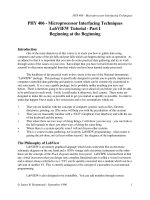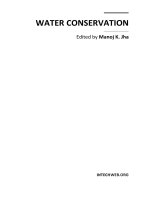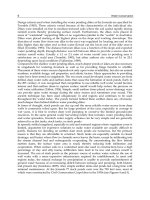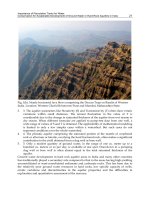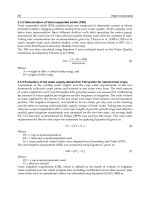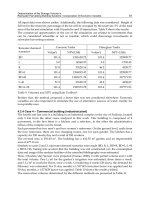Water Conservation Part 1 docx
Bạn đang xem bản rút gọn của tài liệu. Xem và tải ngay bản đầy đủ của tài liệu tại đây (1.75 MB, 15 trang )
WATER CONSERVATION
Edited by Manoj K. Jha
Water Conservation
Edited by Manoj K. Jha
Published by InTech
Janeza Trdine 9, 51000 Rijeka, Croatia
Copyright © 2011 InTech
All chapters are Open Access distributed under the Creative Commons Attribution 3.0
license, which allows users to download, copy and build upon published articles even for
commercial purposes, as long as the author and publisher are properly credited, which
ensures maximum dissemination and a wider impact of our publications. After this work
has been published by InTech, authors have the right to republish it, in whole or part, in
any publication of which they are the author, and to make other personal use of the
work. Any republication, referencing or personal use of the work must explicitly identify
the original source.
As for readers, this license allows users to download, copy and build upon published
chapters even for commercial purposes, as long as the author and publisher are properly
credited, which ensures maximum dissemination and a wider impact of our publications.
Notice
Statements and opinions expressed in the chapters are these of the individual contributors
and not necessarily those of the editors or publisher. No responsibility is accepted for the
accuracy of information contained in the published chapters. The publisher assumes no
responsibility for any damage or injury to persons or property arising out of the use of any
materials, instructions, methods or ideas contained in the book.
Publishing Process Manager Gorana Scerbe
Technical Editor Teodora Smiljanic
Cover Designer InTech Design Team
Image Copyright Tischenko Irina, 2011. Used under license from Shutterstock.com
First published December, 2011
Printed in Croatia
A free online edition of this book is available at www.intechopen.com
Additional hard copies can be obtained from
Water Conservation, Edited by Manoj K. Jha
p. cm.
978-953-307-960-8
free online editions of InTech
Books and Journals can be found at
www.intechopen.com
Contents
Preface VII
Chapter 1 Review of Water-Harvesting Techniques to Benefit Forage
Growth and Livestock on Arid and Semiarid Rangelands 1
Albert Rango and Kris Havstad
Chapter 2 Importance of Percolation Tanks for
Water Conservation for Sustainable Development
of Ground Water in Hard-Rock Aquifers in India 19
Shrikant Daji Limaye
Chapter 3 Performance Assessment and Adoption Status of Family
Drip Irrigation System in Tigray State, Northern Ethiopia 31
Nigussie Haregeweyn, Abraha Gebrekiros, Atsushi Tsunkeawa,
Mitsuru Tsubo, Derege Meshesha and Eyasu Yazew
Chapter 4 Alternative Management Practices for
Water Conservation in Dryland Farming:
A Case Study in Bijar, Iran 47
Fardin Sadegh-Zadeh, Samsuri Abd Wahid,
Bahi J. Seh-Bardan, Espitman J. Seh-Bardan and Alagie Bah
Chapter 5 Determination of the Storage
Volume in Rainwater Harvesting Building Systems:
Incorporation of Economic Variable 67
Marina Sangoi de Oliveira Ilha and Marcus André Siqueira Campos
Chapter 6 Analysis of Potable Water Savings
Using Behavioural Models 89
Marcelo Marcel Cordova and Enedir Ghisi
Chapter 7 Water Management in the Petroleum Refining Industry 105
Petia Mijaylova Nacheva
Chapter 8 Economic Principles for
Water Conservation Tariffs and Incentives 129
John P. Hoehn
Preface
Water is an essential and basic human need for urban, industrial and agricultural use.
While there exists an abundance of fresh water resources is available, its uneven
distribution around the globe creates challenges for the sustainable use of this resource.
According to World Health Organization in 2011, over 1 billion people lack safe drinking
water, approximately 3 billion people lack adequate sanitation, and over 2 million people
die annually from water-related diseases. Various factors such as population growth,
industrialization, food production, and increased global economy activity continue to
challenge water resources management. These factors, coupled with the consequences of
global warming, present many challenges for future generations.
Water conservation refers to an efficient and optimal use as well as protection of
valuable water resources and its users can be broadly classified into two groups: users
(such as residential users, industries and agriculture), and operators (such as
municipalities, state and local government, and privately owned suppliers). Various
tools and techniques have been developed and continue to develop for water
conservation for both groups of water users.
Choice of which water conservation practices adopted depend on types of uses and
suitability of locations.
Some commonly used techniques include rainwater harvesting, water reuse and
recycling, cooling water recycling, irrigation techniques such as drip irrigation,
agricultural management practices, groundwater management, public education,
water conservation incentives, and others. Rainwater harvesting for use in building
systems substitutes the potable water in activities where the use of potable water is not
required. Water-harvesting techniques in arid and semi-arid regions facilitate better
infiltration and increase in soil moisture which promotes significant vegetation growth
for habitat cover and forage. Water conservation through drip irrigation, for instance,
is a very efficient technique where virtually no water is lost to runoff, deep percolation
or evaporation; however, it involves costs that need economic incentives or
justification. Large quantity of waste water generated in industries such as petroleum
refinery can be reused efficiently in the cooling systems. In addition to these and other
tools and techniques for water conservation practices, economical incentives have also
been viewed as an effective tool to promote efficient water conservation.
VIII Preface
This book provides state-of-the-art reviews and various tools and techniques used in
the context of water conservation, with case studies of international perspectives from
India, Mexico, Ethiopia, Brazil, Iran, and Unite States of America. And it is divided
into eight chapters.
Chapter 1 reviews various water-harvesting techniques in arid and semi-arid
rangelands where sparse, sporadic, and spatially widespread rainfall is dominant.
Chapter 2 talks about rain-harvesting techniques for artificial groundwater recharge in
areas of hard-rock aquifer in monsoon climate where rainfall is available only for short
period of time. Chapter 3 presents the case study of a family drip irrigation system in
Northern Ethiopia. Chapter 4 evaluates soil and water conservation techniques
through field experiments on various alternative land management practices in dry
land farming areas. Chapters 5 and 6 elaborate on rain-harvesting techniques in urban
settings. Chapter 7 explains appropriate water management options for wastewater
reuse and water use minimization with case study in two Mexican refineries. And, last
but not the least, Chapter 8 shed lights on various economic principles central to water
resources management and how these principles are used in designing water
conservation tariffs and incentives.
I sincerely hope that this book will be a valuable resource to researchers, instructors,
decision-makers, and others interested in water conservation area. The editor
gratefully acknowledges the hard work and patience of all the authors who have
contributed to this book. The views or opinions expressed in each chapter of this book
are those of the authors. Special thanks go to the editorial team for their hard work
and timely completion of this book.
Manoj K. Jha, Ph.D.,
Professor, Civil Engineering
North Carolina A&T State University, Greensboro, North Carolina,
USA
1
Review of Water-Harvesting Techniques to
Benefit Forage Growth and Livestock on
Arid and Semiarid Rangelands
Albert Rango and Kris Havstad
USDA-ARS Jornada Experimental Range, Las Cruces, New Mexico,
USA
1. Introduction
The term water harvesting means the concentration, collection, and distribution of water
that would naturally exit a landscape through other processes (runoff, evaporation).
Although very simple in concept and ancient in its history of application, it is surprising that
this traditional water management approach is not more commonly implemented. When
utilized, water harvesting is normally found in irrigated agriculture and domestic water
supply applications, usually in less developed and impoverished regions of the globe. It has
been found (Boers & Ben-Asher, 1982) that literature for water harvesting applied to crop
production was sparser than expected. There have been applications on rangeland,
particularly for desired management effects such as enhanced forage growth, landscape
level distribution of livestock water supply, and rehabilitation of deteriorated or degraded
resource conditions. Although applications in irrigated agriculture and domestic water
supply are similar, this chapter focuses on the documented rangeland water harvesting
approaches, which are even less common than those applications for crop production. (e.g.,
Frasier & Myers, 1983, Hudson, 1987, Critchley, et al., 1991, and Renner & Frazier, 1995).
The percentage of the world’s total land surface area occupied by rangeland is between 40%
to 70% depending on the definition used by the author (Branson, et al., 1981; Heady & Child
1994; and Holechek et al., 1995). Approximately 80% of all the world’s rangeland is found in
arid and semiarid regions (Branson et al., 1981), of which, the rangelands in the
southwestern U.S. are good examples. The Jornada Experimental Range (Jornada) in south
central New Mexico is representative of both the southwestern U.S. and the world’s arid to
semiarid rangeland and is a long-term ecological research site that has produced almost a
century of important rangeland research knowledge (Havstad et al., 2006).
There are a number of unanswered questions that will be addressed in this chapter.
Specifically, why haven’t water harvesting techniques been used more frequently in arid
and semiarid rangelands, and where they have been used, what problems have been
encountered and what gaps in our knowledge still exist? Briefly, water harvesting has been
used on rangelands but the documentation of the results are widely scattered. No
insurmountable problems have been encountered, but a synthesis of existing results in one
chapter should provide easier access to the existing literature for informed decisions on
where and how to employ various water harvesting approaches. The authors have reviewed
Water Conservation
2
and assembled key water harvesting documentation which indicates that the techniques are
easily used with the most effective approach for enhancing soil moisture and forage growth
coming from constructing shallow water ponding dikes across known overland flow paths.
For livestock watering, the construction of dirt stock tanks in established water channels
provides valuable water sources for domestic animals as well as wildlife resulting in a
complementary source of water to well water that may otherwise be wasted through the
normal rainfall – evaporation cycle.
The authors have examined the positive and negative aspects of the water harvesting
results. Surprisingly, there are few noted disadvantages. One disadvantage is a lack of
evidence that shallow water ponding dikes have a capability to be self propagating in
regards to vegetation growth. One distinct advantage is that simple traditional treatments
are easy and inexpensive to install. Interestingly, historical and ancient methods are
timeless. Infiltration of water into rangeland soils results in increased soil moisture and
resulting associated forage growth. Still, future research is required over areas larger than
those documented in the literature to see if results will vary based on differences in spatial
scale. There will be a challenge in doing treatments as well as conducting measurements of
soil moisture and forage over much larger areas than those used in the past. However,
research at appropriate spatial scales should lead to more comprehensive recommendations
of how to proceed in water harvesting in arid and semiarid rangelands around the world.
2. Historical applications
2.1 Ancient evidence
Investigators have found evidence in Jordan that water harvesting structures were
constructed over 9,000 years ago and in Southern Mesopotamia over 6,500 years ago (Bruins
et al., 1986). Water harvesting structures used by the Phoenicians in the Negev Desert were
found to date back 3,000 – 4,000 years (Lowdermilk, 1960). Water collection and irrigation
structures in southern Mexico have survived in excellent condition for about 3,000 years
(Caran & Neely, 2006). Water collecting structures were also found in the Negev Desert
dating back at least 2,700 years and probably longer (Evenari et al., 1982). Water harvesting
for irrigation has been practiced in the desert areas of Arizona and northwest New Mexico
for at least the last 1,000 years (Zaunderer & Hutchinson, 1988).
The rainwater harvesting approaches cited as used in the Negev Desert include terraces in
wadis that are still under cultivation by local Bedouins and water harvesting farms
reconstructed as part of an experiment by researchers at local universities (Evenari et al.,
1982). Figure 1 is an aerial photo showing a farm unit near Shivta in the Negev desert that
features terraces in the wadis that slow water flow (Evenari et al., 1982). This allows
infiltration and an increase in soil moisture which enhances the success of cultivation behind
the terraces. To increase the volume of water available for farming, stone-lined conduits
from the surrounding hillsides collect and rapidly transmit rainfall runoff to the cultivated
area.
Figure 2 is a schematic of a water spreading system illustrating floodwaters being delivered
to a sequence of water ponding dikes that have historically been used on rangelands in the
Middle East (Prinz & Malik, 2002, as adapted from French & Hussain, 1964). These types of
water spreaders are typical of those used in arid regions around the world. However, as
reported in Fedelibus & Bainbridge (1995), “like many great solutions to environmental
Review of Water-Harvesting Techniques to
Benefit Forage Growth and Livestock on Arid and Semiarid Rangelands
3
problems, rainfall catchments” (or water harvesting methods) “are a reinterpretation of
ancient techniques developed in the Middle East and Americas, but forgotten by modern
science and technology.”
2.2 Recent History
The availability of relatively inexpensive labor in the period 1934-1942 through Civilian
Conservation Corps (CCC) personnel working at the direction of U.S. Government scientists
produced a large number of land treatment measures throughout the western U. S. drylands.
Peterson & Branson (1962) report that 899 water conservation structures established by the CCC
were located and appraised in 1949 and 1961 in the Upper Gila and Mimbres River watersheds
in Arizona and New Mexico. The effectiveness of the treatments were assessed in terms of
vegetation improvement, longevity, and quantities of sediment retained by the structures. More
than half of the structures were breached by water within several years after construction and
were not functioning as planned. However, the most effective water applications were where
earthen dikes were not breached and water was able to reach the spreader system, which
resulted in vegetation improvement even in the driest areas of the region.
Fig. 1. Aerial photograph of a farm unit near Shivta in the Negev Desert. A terraced wadi and
stone conduits leading runoff from hillsides to terraces are visible (after Evenari et al., 1982)
Water Conservation
4
Fig. 2. Water spreading system in Pakistan to divert excess flood water ponding dikes (after
Prinz & Malik, 2002, as adapted from French & Hussain, 1964).
Another study (Miller et al., 1969) of water spreader effectiveness found that the response of
forage vegetation was dependent on rainfall characteristics, runoff production, and drainage
of water detained in ponds behind dikes. If a site received less than 200 mm annual
precipitation or less than 100-130 mm during the growing season, it would typically not
produce enough runoff to justify installation of a water spreader (Bennett, 1939). Results
produced by Valentine (1947), Hubbell & Gardner (1950), Hubbard & Smoliak (1953),
Branson (1956), Houston (1960), and Hadley & McQueen (1961) showed increases in yield of
forage grasses from small to large amounts (Miller et al., 1969). Forage production occurred
only on those sites that received a minimum of at least one flooding event per year. The
amount of soil moisture in the soil profile had more influence than soil texture on forage
produced. More forage was also produced when ponded water could drain completely from
the soil surface between rainfall events.
Similar work has also been done in other arid and semiarid regions of the world. As an
example, Cunningham et al. (1974) have reported on the use of water ponding dikes to reclaim
extensive bare soil areas (scalds) in Australia. This water ponding approach yielded almost
double the amount of forage obtained from nearby non-scald areas with the same soil type.
Scalds are formed through a combination of wind and water erosion removing surface soil to
expose the subsoil which subsequently becomes very impervious (Warren, 1965; Cunningham
et al., 1974). Soil berms of 30-45 cm high were constructed using a road grader that allowed
ponding of surface runoff that was trapped behind a berm after a rainfall event.
Some of the most recent water ponding dikes constructed in the United States were on the
Jornada to evaluate the efficiency of the shallow structures to increase forage. Twenty-five
dikes in four separate areas of the Jornada were installed between 1975-1981 (Rango et al.,
2006). These types of dikes can be constructed with a tractor and mold board plow or with a
road grader as in this experiment (See Figure 3).
Review of Water-Harvesting Techniques to
Benefit Forage Growth and Livestock on Arid and Semiarid Rangelands
5
a b
c
Fig. 3. Development of water ponding dikes at the Jornada showing a) 15cm dikes at the Ace
Tank during construction with a road grader in 1975; b) 7.5cm dikes at Taylor Well during
construction (accomplished using a mold board plow); and c) water ponding behind a 7.5cm
dike at Taylor Well.
The height of the dikes ranged from a low of 7.5 cm to a high of 30 cm (See Table 1). The
orientation of the dikes are typically perpendicular to the general direction of the overland
flow. Additionally, multiple dikes are often arranged so that dikes downslope can catch any
overflow from the upslope dikes. A crescent shape dike was usually employed to gather the
water into a shallow pond. The resulting pattern of the dikes and vegetation growth
approximate the pattern of natural banded vegetation which serves a similar function,
namely, slowing down overland flow over bare areas, allowing the water to infiltrate into
the soil moisture reservoir, and a resulting increase in vegetation growth (Tongway et al.,
2001).
Location
Date
Installed
Height
Number of
Dikes
Soil Texture
Taylor Well 1975 7.5 cm 5 Fine
Ace Tank 1975 15 cm 5 Fine
Brown Tank 1978 15 cm 3 Fine
Dona Ana Exclosure 1981 30 cm 12 Medium-Coarse
Table 1. Attributes of water ponding dikes established on the Jornada Experimental Range
in southcentral New Mexico.
